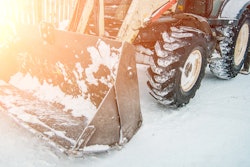
By Barry Eagle
Winter on a construction site comes with a whole host of hazards. From slips and trips to frozen fingers and damaged equipment, cold temperatures require specific countermeasures to ensure a safe and productive site during the winter months.
1. Winter checks and inspections
Prior to the winter season, roadways and parking areas should be maintained so they are free of pot holes and uneven surfaces. Once the ground is frozen, access maintenance becomes much more difficult. Having a well-maintained road before winter starts will make snow removal and maintenance easier once worse conditions blow in. Any holes, excavations or ditching that can't be filled in should be delineated using barricades and marked clearly, even if it snows.
As part of the usual on-site checks, take the time to specifically consider problems that only occur during winter. Inclines that appear perfectly benign in autumn could potentially becomes dangerous slipping hazards with a little ice, especially on wooden ramps and scaffolding.
Keep any reserves of sand, salt or grit you plan to use readily available, and create a safe procedure to implement safety measures when the time comes.
Make sure fluids, such as engine and hydraulic oils, in your equipment are rated for the temperatures in your area, and replace them if needed. Check that heaters in cabs are working properly, and regularly clear off ice or snow from windscreens and steps.
Drain fluid from air compressor tanks after each use to prevent the moisture that has accumulated from freezing and damaging the tank. Put antifreeze tool oil in your pneumatic tools and air hoses to protect against the cold. You should also ensure that tools are used differently in cold weather. For example, fire empty nail guns at 40 PSI in freezing temperatures to warm them up before use.
Near the end of the winter season it will be time to prepare for spring melt. Good site preparation during pre-season planning will ensure that preparations for spring melt are already in place.
At the end of the winter season equipment and materials may need to be ordered that will be needed for spring melt such as pumps and hoses for dewatering. Prior to spring melt, review the plan and ensure that planned water run-off areas are still appropriate.
Also, determine if ditching systems will be able to handle the amount of water that may accumulate based on the amount of snow. Assume the worst-case scenario and that all the snow will melt very quickly.
2. Removing snow and ice
The act of shoveling snow can be extremely strenuous, especially for those individuals who do not engage in regular cardiovascular activity. Studies have shown that that cold temperatures can constrict arteries, which increases blood pressure and the chance of a heart attack.
If workers have any heart attack risk factors — including coronary artery disease, an age over 45 for men or 55 for women, high cholesterol, diabetes, obesity etc. — they shouldn't engage in manual snow shovelling.
Snow removal equipment creates extremely slippery surfaces after snow has been removed. To mitigate this, grit should be distributed after the equipment has completed snow removal.
If you opt to use de-icer, make sure site environmental requirements are met. Some sites prohibit the use of de-icers that are salt based as they can change the pH and conductivity of ground water.
3. Preventing workers from slipping on icy surfaces
Slips and falls are one of the most common construction site accidents, and they can happen all year round. However, winter weather increases the risk of falls due to ice and wet, slippery surfaces.
When surfaces become cold, ice can accumulate on scaffolding, ladders, walkways, stairs and work platforms. If these areas are not treated correctly, built from weather resistant materials, or cordoned off, they can cause workers to slip and fall. If this occurs at height, injuries can include broken bones, fractures, traumatic brain injuries and even death.
Prevention is essential when protecting against slips and trips, so keeping hand rails and walkways free of snow and ice is vital. Where you cannot provide safety to workers, make sure those areas are clearly marked to prevent access.
4. Keep worker exposure to freezing temperatures to a minimum
Workers who aren’t accustomed to freezing temperatures are particularly susceptible to cold stress, but everyone can suffer the effects of extreme cold.
Freezing temperatures cause skin and internal body temperatures to drop, causing frostbite, chilblains and even hypothermia. All of this can cause serious illnesses that can result in permanent tissue damage or, in more serious cases, death.
If work cannot be rescheduled, consider setting up warm areas for workers and make hot drinks accessible during breaks. You should also consider running shorter shifts to reduce exposure time and physical exertion.
5. Personal protection equipment in cold weather
Winter personal protection equipment (PPE) can be bulky and limit mobility. As a result, over protection may result in unnecessary hazards to workers. It's important to balance protection against the cold and the hazards of the job task, while still allowing mobility and dexterity to complete tasks. Choosing PPE that is insufficient for the task or the conditions can lead to a number of additional hazards, including:
- Blocked vision or loss of peripheral vision
- Layering around ears preventing hearing
- Eyewear fogging
- Snow glare
- Decreased dexterity
- Lack of mobility
- Inadequate traction for ground conditions
Selecting PPE that best suits the task and the conditions will ensure the risk of injury is mitigated to a level as low as possible without compromising productivity.
Gloves need to be heavy and durable, but with the right fabric and texture to allow you to remain dexterous. They should also be durable and waterproof in case of rain, melting snow and ice.
Waterproofing is as important for gloves as it is for boots. Insulated boots keep your feet warm and dry. If moisture gets in, amount of layers will keep your feet warm. They also need to be breathable, so perspiration can get out.
Finally, footwear should provide adequate traction when working at winter construction sites to reduce the chance of slipping.
Barry Eagle is managing director at GripClad, which supplies retro-fit and structural anti-slip flooring surfaces for industrial, commercial and public-access areas.



















